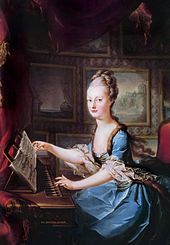art.wikisort.org - Artist
Franz Xaver Wagenschön (2 September 1726, Littisch, Bohemia (now Litíč, Czech Republic) – 1 January 1790, Vienna) was a German Bohemian painter of the Rococo and Neoclassical styles. His works are to be found in the Kunsthistorisches Museum of Vienna, in Graz and in Upper Austria.

Life
In 1747 he went to Vienna to attend the local art academy, becoming a member of it in 1770. He was also a student of Paul Troger. In his early years he was a carriage painter, producing portraits of noblemen, working in this vein at the end of the 1760s for the children of Maria Theresa of Austria, especially Marie Antoinette (later queen of France), and in 1763 painting the panels for the golden Imperialwagen. In later life he produced religious and allegorical works influenced by the Italian Baroque. He was also known for his works for monasteries and churches, including Poysdorf, Göttweig, Ollersbach, Scheibbs, Purgstall and Tulln.
Gallery
- The Crowning of Mary
- Resurrection of Christ
- Jael and Sisera
- Saint Florian (circa 1778)
- Saint Stephen
- Christ raises Lazarus from death (circa 1763)
- Christ heals the blind (circa 1763)
Sources
- Radka Miltová: "Franz Xaver Wagenschön a "Metamorphoses d'Ovide en rondeaux“
External links
На других языках
[de] Franz Xaver Wagenschön
Franz Xaver Wagenschön (* 2. September 1726 in Littisch bei Jaroměř, Böhmen; † 1. Januar 1790 in Wien) war ein österreichischer Maler des Rokoko und Klassizismus.- [en] Franz Xaver Wagenschön
Другой контент может иметь иную лицензию. Перед использованием материалов сайта WikiSort.org внимательно изучите правила лицензирования конкретных элементов наполнения сайта.
WikiSort.org - проект по пересортировке и дополнению контента Википедии






